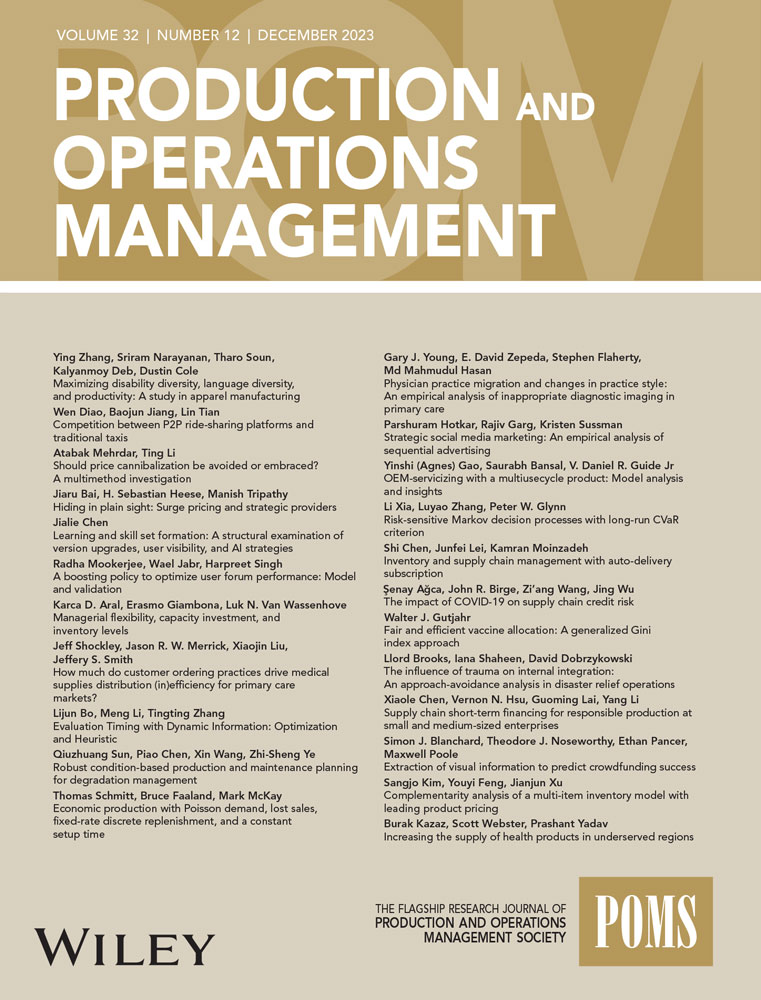在服务不足的地区增加卫生产品的供应
IF 5.1
3区 管理学
Q1 ENGINEERING, MANUFACTURING
引用次数: 0
摘要
摘要:本文研究了鼓励保健品制造商建立生产和分销能力的机制。这对于支付能力较低且需求风险较大的中低收入国家(LMIC)市场非常重要。发展金融机构和慈善机构正在开始利用新的工具来激励制造商建立面向低收入和中等收入国家市场的生产/分销能力。本文的目的是了解这些机制在不同情况下的有效性。我们研究了四种工具:(1)与单位销售成比例的补贴(销售补贴),(2)与单位容量成比例的补贴(可变容量补贴),(3)与总容量投资成比例的补贴(总容量补贴),(4)最低产量保证。我们分析了激励能力作为每种工具的社会投资者预算的函数。我们展示了如何使用我们的框架在给定相关参数估计的情况下识别社会投资者的首选工具,并提供了对特定工具占主导地位的设置类型的见解。当支付能力很低时,销售补贴占主导地位;当支付能力较低时,总容量补贴占主导地位。在这些设置之外,乐器偏好是微妙的,尽管销售补贴至少由另一种乐器主导。当支付能力适中时,在高可变容量成本和高预算条件下,更倾向于采用可变容量补贴;在低可变容量成本和高预算条件下,更倾向于采用容量保证;在低预算条件下,更倾向于采用总容量补贴。这篇文章受版权保护。版权所有本文章由计算机程序翻译,如有差异,请以英文原文为准。
Increasing the supply of health products in underserved regions
Abstract We study mechanisms that encourage manufacturers of health products to build production and distribution capacity. This is important for low‐ and middle‐income country (LMIC) markets where ability to pay is lower and demand risks are greater. Development finance institutions and philanthropies are beginning to utilize new instruments to incentivize manufacturers to build production/distribution capacity for LMIC markets. The goal of this paper is to understand the effectiveness of such mechanisms in different settings. We examine four instruments: (1) subsidy proportional to unit sales (sales subsidy), (2) subsidy proportional to unit capacity (variable‐capacity subsidy), (3) subsidy proportional to total capacity investment (total‐capacity subsidy), (4) a minimum volume guarantee. We analyze incentivized capacity as a function of social‐investor budget for each instrument. We show how our framework can be used to identify a social investor's preferred instrument given relevant parameter estimates, and we provide insight into the type of settings where a particular instrument dominates. A sales subsidy dominates when ability to pay is very low; a total‐capacity subsidy dominates when ability to pay is low. Outside of these settings, instrument preference is nuanced, though a sales subsidy is dominated by at least one other instrument. When ability to pay is moderate, a variable‐capacity subsidy tends to be preferred under high variable‐capacity cost and high budget, a volume guarantee tends to be preferred under low variable‐capacity cost and high budget, and a total‐capacity subsidy tends to be preferred under low budget. This article is protected by copyright. All rights reserved
求助全文
通过发布文献求助,成功后即可免费获取论文全文。
去求助
来源期刊

Production and Operations Management
管理科学-工程:制造
CiteScore
7.50
自引率
16.00%
发文量
278
审稿时长
24 months
期刊介绍:
The mission of Production and Operations Management is to serve as the flagship research journal in operations management in manufacturing and services. The journal publishes scientific research into the problems, interest, and concerns of managers who manage product and process design, operations, and supply chains. It covers all topics in product and process design, operations, and supply chain management and welcomes papers using any research paradigm.
 求助内容:
求助内容: 应助结果提醒方式:
应助结果提醒方式:


